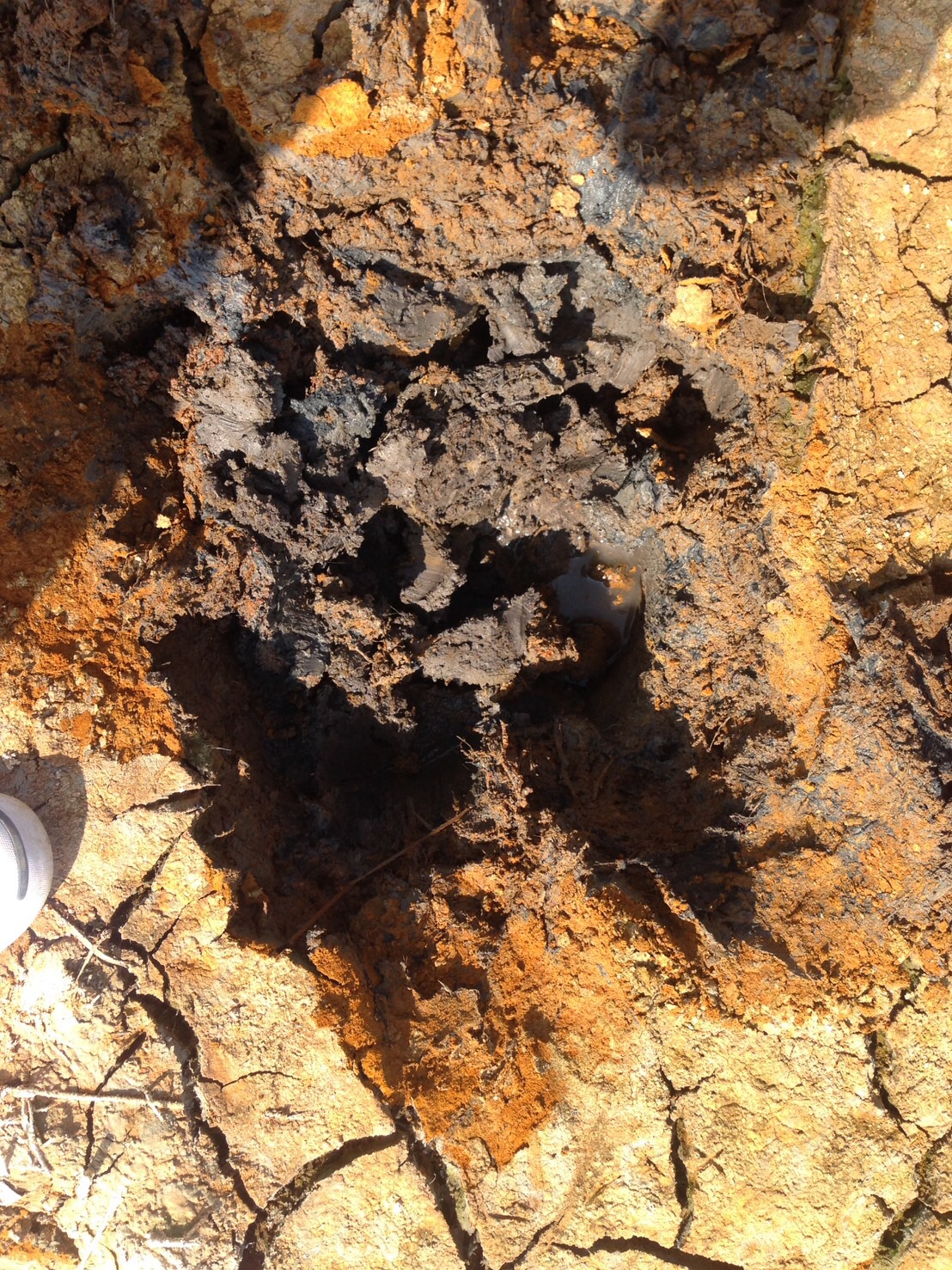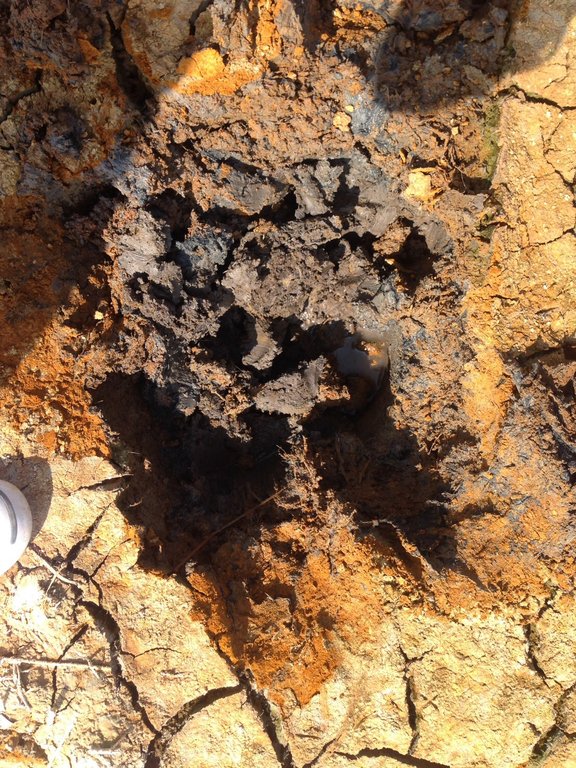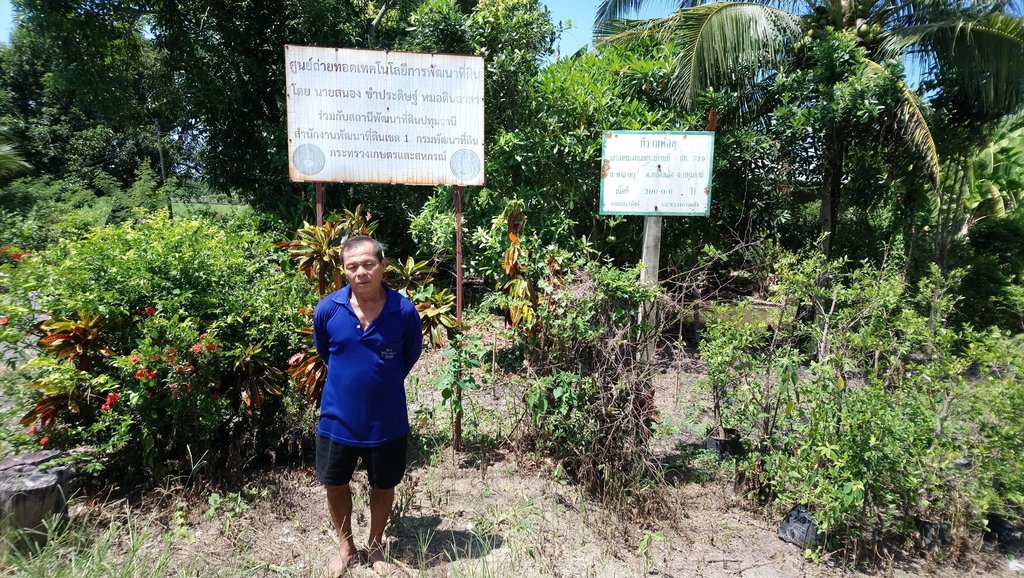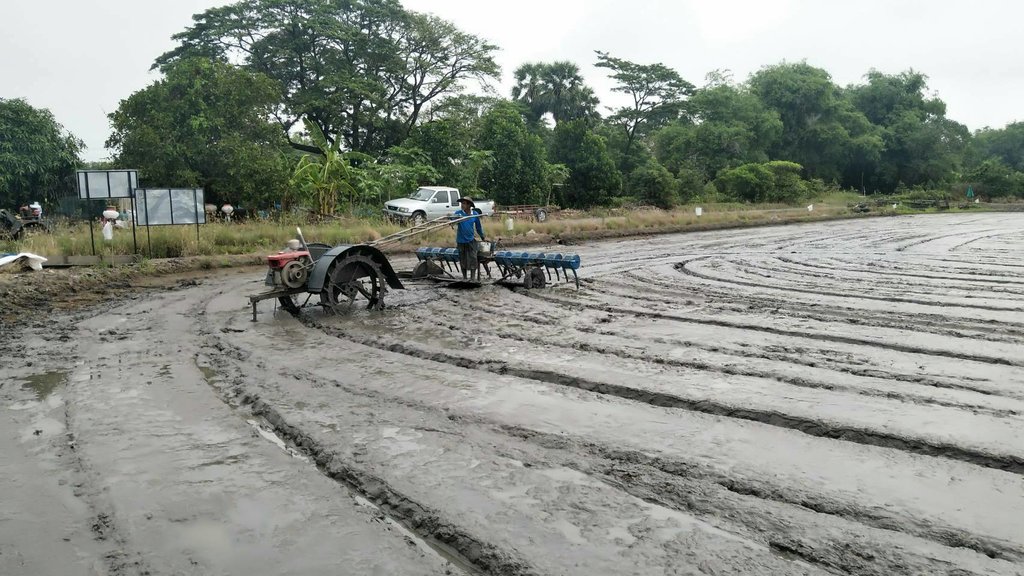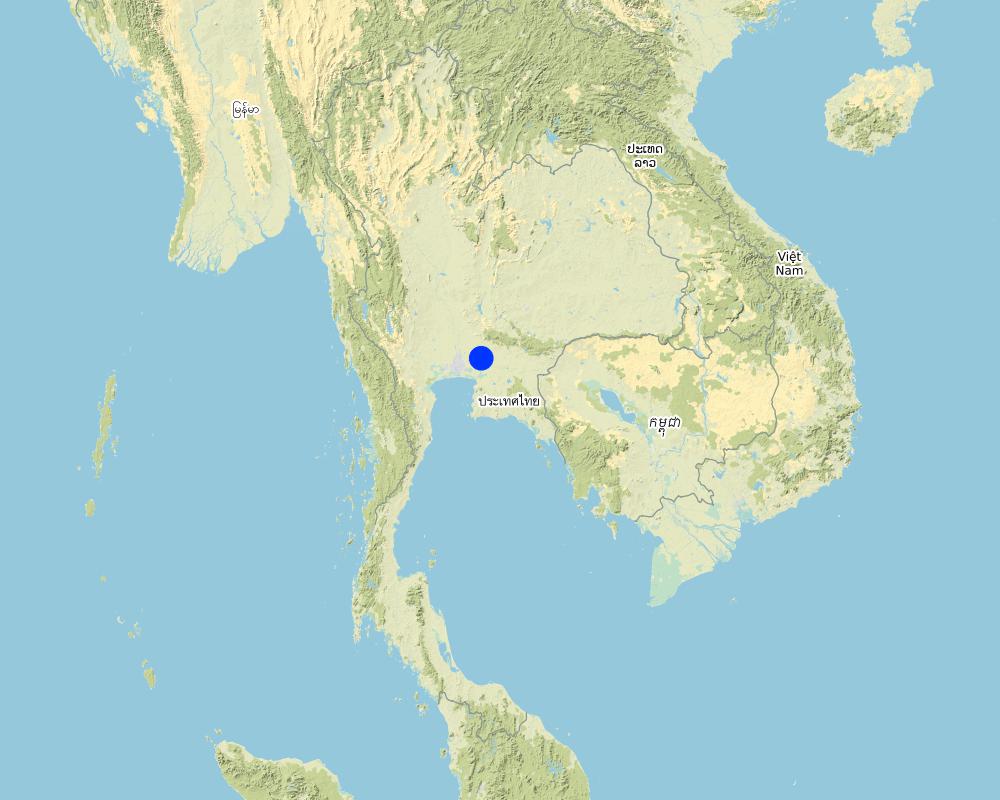The application of marl to improve acid soils [泰国]
- 创建:
- 更新:
- 编制者: Bunjirtluk Jintaridth
- 编辑者: –
- 审查者: Rima Mekdaschi Studer, Pitayakon Limtong, William Critchley
-
technologies_4312 - 泰国
查看章节
全部展开 全部收起1. 一般信息
1.2 参与该技术评估和文件编制的资源人员和机构的联系方式
关键资源人
土地使用者:
1.3 关于使用通过WOCAT记录的数据的条件
编制者和关键资源人员接受有关使用通过WOCAT记录数据的条件。:
是
1.4 所述技术的可持续性声明
这里所描述的技术在土地退化方面是否存在问题,导致无法被认为是一种可持续的土地管理技术?:
否
2. SLM技术的说明
2.1 技术简介
技术定义:
Acid soils are problematic, and the use of alkaline materials such as marl - agricultural lime that is excavated - helps to reduce the acidity and make the soil more productive.
2.2 技术的详细说明
说明:
Adding marl to soils helps to manage acidity. Acidity is a problem in soil caused by iron sulphate that becomes sulfuric acid (H2SO4) upon oxidizing when exposed to the air. Therefore, it requires agricultural lime that are hydroxide, oxide compounds or carbonate with calcium or magnesium as the main component to neutralize or partly reduce the acidity. Agricultural lime is available mainly in the forms of slaked lime, marl, or ground limestone.
Acid sulfate soils are formed from the sediments of seawater or brackish water containing pyrite that changes to sulfuric acid upon oxidizing and accumulate in the soil. Acid sulfate soils are highly acidic, with low fertility. They are severely deficient in nutrients essential for plant growth such as phosphorus and nitrogen. Moreover, there are certain elements that are harmful to the plant growth such as iron, aluminium, manganese. Acid sulfate soils in Thailand occur along the East Coast, the West Coast and in the east part of the southern peninsula. Land Development Department reported that 35% of areas with acid sulfate soils are medium to severely acidic, limiting rice yields to between 625 and 1,560 kg/ha. When the Land Development Department started in 1963, it put the Acid Sulfate Soils Improvement as one of its prominent programs - and work still goes on up to now. The general practice has been to furnish farmers in the affected area with 1 ton of marl (CaCO3 deposit, excavated from the marl pit in Saraburi Province) per rai ( 6.25 rai = one ha). The objectives of using this technology are to (1) improve soils of acid property as soils are the basic resource for plant production, and (2) to increase the production of rice. Before applying marl, the land should be well levelled so that marl can react with acid soil efficiently. Tractors can enter and drop marl sacks over the paddy area, which is then spread by hand. The rate of marl to apply is around 6-12 tons/ha, depending on the soil pH.
2.3 技术照片
2.5 已应用该技术的、本评估所涵盖的国家/地区/地点
国家:
泰国
区域/州/省:
Patumthani
有关地点的进一步说明:
Thung Rangsit area in the past was planted mainly to rice. Previously, the area of Moo 8, Moo 9, Salakru sub-district, Nong Suea district was Ratchaphatsadu land (state property) whereby the government allocated the land for not more than 4 hectares per farmer in 1969.
具体说明该技术的分布:
- 适用于特定场所/集中在较小区域
技术现场是否位于永久保护区?:
否
Map
×2.6 实施日期
如果不知道确切的年份,请说明大概的日期:
- 10-50年前
2.7 技术介绍
详细说明该技术是如何引入的:
- 通过土地使用者的创新
- 作为传统系统的一部分(> 50 年)
3. SLM技术的分类
3.1 该技术的主要目的
- 改良生产
- 减少、预防、恢复土地退化
- 保护生态系统
- 结合其他技术保护流域/下游区域
- 创造有益的经济影响
3.2 应用该技术的当前土地利用类型
同一土地单元内混合使用的土地::
否

农田
- 一年一作
年作 - 具体指明作物:
- 谷类 - 水稻(湿地)
每年的生长季节数:
- 2
采用间作制度了吗?:
否
采用轮作制度了吗?:
否
3.3 由于技术的实施,土地使用是否发生了变化?
由于技术的实施,土地使用是否发生了变化?:
- 是(请在技术实施前填写以下有关土地利用的问题)
同一土地单元内混合使用的土地::
否

农田
- 一年一作
年作 - 具体指明作物:
- 谷类 - 水稻(湿地)
采用间作制度了吗?:
否
采用轮作制度了吗?:
否
3.4 供水
该技术所应用土地的供水:
- 混合雨水灌溉
3.5 该技术所属的SLM组
- 土壤肥力综合管理
3.6 包含该技术的可持续土地管理措施

农艺措施
- A2:有机质/土壤肥力
- A3:土壤表面处理
A3:区分耕作制度:
A 3.2: Reduced tillage (> 30% soil cover)
3.7 该技术强调的主要土地退化类型

化学性土壤退化
- Ca:酸化
3.8 防止、减少或恢复土地退化
具体数量名该技术与土地退化有关的目标:
- 减少土地退化
- 修复/恢复严重退化的土地
4. 技术规范、实施活动、投入和成本
4.2 有关投入和成本计算的一般信息
具体说明成本和投入是如何计算的:
- 每个技术区域
注明尺寸和面积单位:
1 ha
如相关,注明美元与当地货币的汇率(例如1美元=79.9巴西雷亚尔):1美元=:
32.0
注明雇用劳工的每日平均工资成本:
384 Baht
4.3 技术建立活动
| 活动 | 时间(季度) | |
|---|---|---|
| 1. | Soil analysis before the application of marl to know the rates of marl requirement | before land preparation |
| 2. | Paddy should be adjusted or minimum tilled because marl can react with acid soil efficiently. | during land preparation |
| 3. | Spreading the marl all over the plot. | during land preparation |
| 4. | Pumping water into the plot up to 10 cm above the soil level. Keep the water until the soil becomes soft. | during land preparation |
| 5. | Mixing the marl and wet soil and leave the mixture between 3-7 days. | during land preparation |
| 6. | Applying the chemical fertilizer with the recommended rate | during land preparation |
| 7. | Harvesting rice | harvest time |
4.4 技术建立所需要的费用和投入
| 对投入进行具体说明 | 单位 | 数量 | 单位成本 | 每项投入的总成本 | 土地使用者承担的成本% | |
|---|---|---|---|---|---|---|
| 劳动力 | Labor costs for spraying herbicides | baht per hectares | 2.0 | 20.0 | 40.0 | 100.0 |
| 设备 | pumping water | baht per time | 1.0 | 100.0 | 100.0 | |
| 肥料和杀菌剂 | chemical fertilizer | baht per hectares | 1.0 | 200.0 | 200.0 | 100.0 |
| 肥料和杀菌剂 | herbicides | baht per hectares | 1.0 | 59.0 | 59.0 | 100.0 |
| 其它 | marl | dollars per hectare | 1.0 | 36.0 | 36.0 | 100.0 |
| 其它 | seeds | dollars per hectare | 1.0 | 84.0 | 84.0 | 100.0 |
| 技术建立所需总成本 | 519.0 | |||||
| 技术建立总成本,美元 | 16.22 | |||||
如果土地使用者负担的费用少于100%,请注明由谁负担其余费用:
-
注释:
-
4.5 维护/经常性活动
| 活动 | 时间/频率 | |
|---|---|---|
| 1. | - | - |
4.6 维护/经常性活动所需要的费用和投入(每年)
| 对投入进行具体说明 | 单位 | 数量 | 单位成本 | 每项投入的总成本 | 土地使用者承担的成本% | |
|---|---|---|---|---|---|---|
| 劳动力 | - | - |
如果土地使用者负担的费用少于100%,请注明由谁负担其余费用:
-
注释:
-
4.7 影响成本的最重要因素
描述影响成本的最决定性因素:
herbicide price, marl price, and labour cost
5. 自然和人文环境
5.1 气候
年降雨量
- < 250毫米
- 251-500毫米
- 501-750毫米
- 751-1,000毫米
- 1,001-1,500毫米
- 1,501-2,000毫米
- 2,001-3,000毫米
- 3,001-4,000毫米
- > 4,000毫米
农业气候带
- 半湿润
5.2 地形
平均坡度:
- 水平(0-2%)
- 缓降(3-5%)
- 平缓(6-10%)
- 滚坡(11-15%)
- 崎岖(16-30%)
- 陡峭(31-60%)
- 非常陡峭(>60%)
地形:
- 高原/平原
- 山脊
- 山坡
- 山地斜坡
- 麓坡
- 谷底
垂直分布带:
- 0-100 m a.s.l.
- 101-500 m a.s.l.
- 501-1,000 m a.s.l.
- 1,001-1,500 m a.s.l.
- 1,501-2,000 m a.s.l.
- 2,001-2,500 m a.s.l.
- 2,501-3,000 m a.s.l.
- 3,001-4,000 m a.s.l.
- > 4,000 m a.s.l.
说明该技术是否专门应用于:
- 不相关
5.3 土壤
平均土层深度:
- 非常浅(0-20厘米)
- 浅(21-50厘米)
- 中等深度(51-80厘米)
- 深(81-120厘米)
- 非常深(> 120厘米)
土壤质地(表土):
- 中粒(壤土、粉土)
土壤质地(地表以下> 20厘米):
- 中粒(壤土、粉土)
表土有机质:
- 高(>3%)
5.4 水资源可用性和质量
地下水位表:
5-50米
地表水的可用性:
好
水质(未处理):
仅供农业使用(灌溉)
水质请参考::
地表水
水的盐度有问题吗?:
否
该区域正在发生洪水吗?:
否
5.5 生物多样性
物种多样性:
- 中等
栖息地多样性:
- 中等
5.6 应用该技术的土地使用者的特征
定栖或游牧:
- 定栖的
生产系统的市场定位:
- 生计(自给)
- 商业/市场
非农收入:
- 低于全部收入的10%
相对财富水平:
- 平均水平
个人或集体:
- 团体/社区
机械化水平:
- 机械化/电动
性别:
- 男人
土地使用者的年龄:
- 中年人
5.7 应用该技术的土地使用者使用的平均土地面积
- < 0.5 公顷
- 0.5-1 公顷
- 1-2 公顷
- 2-5公顷
- 5-15公顷
- 15-50公顷
- 50-100公顷
- 100-500公顷
- 500-1,000公顷
- 1,000-10,000公顷
- > 10,000公顷
这被认为是小规模、中规模还是大规模的(参照当地实际情况)?:
- 中等规模的
5.8 土地所有权、土地使用权和水使用权
土地所有权:
- 州
土地使用权:
- 社区(有组织)
用水权:
- 社区(有组织)
土地使用权是否基于传统的法律制度?:
是
5.9 进入服务和基础设施的通道
健康:
- 贫瘠
- 适度的
- 好
教育:
- 贫瘠
- 适度的
- 好
技术援助:
- 贫瘠
- 适度的
- 好
就业(例如非农):
- 贫瘠
- 适度的
- 好
市场:
- 贫瘠
- 适度的
- 好
能源:
- 贫瘠
- 适度的
- 好
道路和交通:
- 贫瘠
- 适度的
- 好
饮用水和卫生设施:
- 贫瘠
- 适度的
- 好
金融服务:
- 贫瘠
- 适度的
- 好
6. 影响和结论性说明
6.1 该技术的现场影响
社会经济效应
生产
作物生产
生产区域
土地管理
收入和成本
农业收入
社会文化影响
食品安全/自给自足
SLM/土地退化知识
生态影响
土壤
养分循环/补给
酸度
6.4 成本效益分析
技术收益与技术建立成本相比如何(从土地使用者的角度看)?
短期回报:
积极
长期回报:
非常积极
技术收益与技术维护成本/经常性成本相比如何(从土地使用者的角度看)?
短期回报:
中性/平衡
长期回报:
中性/平衡
6.5 技术采用
- > 50%
在所有采用这项技术的人当中,有多少人是自发的,即未获得任何物质奖励/付款?:
- 91-100%
6.6 适应
最近是否对该技术进行了修改以适应不断变化的条件?:
是
若是,说明它适应了哪些变化的条件:
- 不断变化的市场
6.7 该技术的优点/长处/机会
| 土地使用者眼中的长处/优势/机会 |
|---|
| Marl is an alkaline material, which can be used to solve the problem of the soil having acidity. The effect can last for several years. The cost of acid soil improvement by applying marl is low; farmers can invest in it. |
| Applying marl will increase more fertility to the soil, as there are nutrients with positive charges, namely calcium (Ca) and magnesium (Mg). |
| Applying marl will hasten the decomposition of organic matter in the soil and bring in more nitrogen in the form that plants can utilize better. |
| 编制者或其他关键资源人员认为的长处/优势/机会 |
|---|
| Applying marl will hasten the decomposition of organic matter in the soil and bring in more nitrogen in the form that plants can utilize better. |
| Phosphorus still remains in the form useful to plants. As acidity is reduced, the solubility of toxic elements, namely aluminium (Al3+) and iron (Fe2+) is also reduced. |
| Lime has the property in making soil friable. |
6.8 技术的弱点/缺点/风险及其克服方法
| 土地使用者认为的弱点/缺点/风险 | 如何克服它们? |
|---|---|
| Too much application of marl will make the rice plant become yellow because rice does not like strong alkalinity. | Use liming materials following lime requirement from laboratory analysis |
| 编制者或其他关键资源人员认为的弱点/缺点/风险 | 如何克服它们? |
|---|---|
| Too much application of marl will make the rice plant become yellow because rice does not like strong alkalinity. | Use liming materials following lime requirement from laboratory analysis |
7. 参考和链接
7.1 信息的方法/来源
- 与土地使用者的访谈
5 land users
- 与SLM专业人员/专家的访谈
4 SLM specialists
(现场)数据是什么时候汇编的?:
24/12/2018
注释:
-
7.2 参考可用出版物
标题、作者、年份、ISBN:
acid sulfate soil improvement
可以从哪里获得?成本如何?
Land Development Department
7.3 链接到网络上的相关信息
标题/说明:
acid sulfate soil improvement
链接和模块
全部展开 全部收起链接
无链接
模块
无模块


